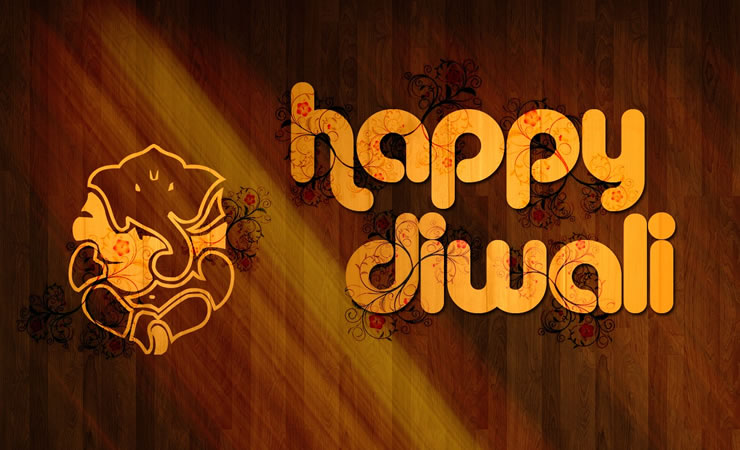Shubh Deepavali – Happy Diwali – Celebrate the Festival of Lights 2014
The vibrant festival of Deepavali (also referred to as Diwali in recent years) is the largest and most widely celebrated festival for Hindus and Indians. Diwali is followed and celebrated with strong enthusiasm in India as well as other nations with significant populations of Hindus, Sikhs and NRIs. Such nations include the USA, Canada, Australia, UK, Trinidad, Guyana, Fiji, Mauritius, Nepal, Sri Lanka, Singapore, Thailand, New Zealand and the island of Bali (Indonesia). Unlike many other religious celebrations worldwide that are followed primarily by a single religious community, Diwali (Deepavali) is celebrated by various Dharmic religions, which include the spiritual religions of Hinduism, Sikhism, Jainism and Buddhism. The true interpretation of Deepavali equates to a ‘row of lighted lamps/diyas’. Diwali also has significant symbolism of ‘Good vs. Evil’ and ‘Light vs. Dark’, therefore being called the ‘Festival of Lights’ in the western world. Along with prayers and pujas, Diwali is a holiday time when families and friends visit each other, light candles & diyas, create colourful rangoli, play with fireworks, distribute Indian and Hindu sweets, dance and share traditional and religious stories. Another reason making Deepavali is treated as a more special time is that it is the end of the harvest season in most parts of rural-filled India.
Deepavali is celebrated for 5 days, where the 3rd days is celebrated as the main Deepavali festival. Diwali is celebrated primarily on October 23rd this uear. Different colourful varieties of fireworks and lights are associated with this festival. On this positive & auspicious day, people light up diyas (candles) all around their houses and businesses. They perform Lakshmi Pooja late in the day and pray for divine blessings of Lakshmi, who is the Goddess of Wealth. The festival of Deepavali is never complete without the distribution of gifts and mithai (indian sweets). People present Diwali presents and Indian sweets to all relatives and loved ones. Nowadays, many elders give younger kids gifts or money, similar to the western practice of Christmas.
Here is a more in depth description of Deepavali in each Dharmic religion:
Deepavali Festival for Hindus
Under Hinduism, the exact day of Deepavali is decided by the position of the moon. According to the Hindu calendar, Amavasya or ‘no moon day’ is considered as the perfect day to celebrate Deepavali. This dark night comes after every fortnight and in the month of Kartik, it marks this festival of lights and diyas. As per the Western English calendar, the festival generally comes in the month of November and December. For all Hindu people, the festival holds an imperative meaning since the festival is reckoned with Lord Rama’s victory as the King of Ayodhya after his return to the kingdom from 14 years of exile along with his wife Sita and brother Laxman after killing the demon, King Ravana. The festival is celebrated by lighting diyas and candles to drive away the darkness of Amavasya.
The festival starts with Dhanteras on which most Indian business communities begin their financial year. The second day of the festival, Naraka Chaturdasi, marks the vanquishing of the demon Naraka by Lord Krishna and his wife Satyabhama. Amavasya, the third day of Deepawali, marks the worship of Lakshmi, the goddess of wealth in her most benevolent mood, fulfilling the wishes of her devotees. Amavasya also tells the story of Lord Vishnu, who in his dwarf incarnation vanquished the Bali, and banished him to Patala. It is on the fourth day of Deepawali, Kartika Shudda Padyami, that Bali went to patala and took the reins of his new kingdom in there. The fifth day is referred to as Yama Dvitiya (also called Bhai Dooj), and on this day sisters invite their brothers to their homes.
The name “Diwali” is a contraction of “Deepavali”, which translates into “row of lamps”. Diwali involves the lighting of small clay lamps (diyas or dipas) filled with oil to signify the triumph of good over evil. During Diwali, all the celebrants wear new clothes and share sweets and snacks with family members and friends.
Diwali (Bandi Chhorh Divas) Festival for Sikhs
In Sikhism, Diwali is particularly important which they celebrate after the celebration of Bandi Chhorh Divas (the Day of Freedom), celebrating the release from prison of the Sixth Guru, Guru Hargobind Ji, and 52 other princes with him, in 1619. The Sikh tradition holds that the Emperor Jahangir had imprisoned Guru Hargobind Ji and 52 princes. Sikhs celebrated the return of their Guru by lighting the Sri Harmandir Sahib (Golden Temple) and this tradition continues today.
Deepavali (Mahavira Moksha) Festival for Jains
In Jainism, Diwali marks the attainment of moksha or nirvana by Mahavira in 527 BC. Mahavira is responsible for establishing the Dharma followed by Jains even today. According to tradition, the chief disciple of Mahavira, Ganadhara Gautam Swami also attained complete knowledge (Kevalgyana) on this day, thus making Diwali one of the most important Jain festivals.
Diwali (Ashok Vijayadashami) for Buddhists
While not a large occasion in some sections of Buddhism including Newar Buddhists celebrate Diwali through the chanting of mantras and remembering Emperor Ashoka who converted to Buddhism on this day, and therefore Buddhists also know the festival as Ashok Vijayadashami.
The Chakra team would like to wish everyone a shubh/happy deepavali and may everyone fight the evil within them.






